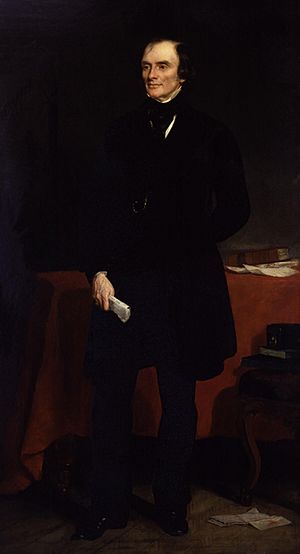First Russell ministry facts for kids
Lord John Russell, a leader from the Whig Party, was the head of the government in the United Kingdom of Great Britain and Ireland from 1846 to 1852. He was like the Prime Minister of his time.
Contents
Russell's Government: A Look Back
After the Tory Party split in 1846, the Whigs took over. This split happened because of disagreements over the Corn Laws, which were rules about importing grain. Sir Robert Peel's government ended, and Lord John Russell became the new leader.
In his team, important roles were filled by:
- Sir Charles Wood as the Chancellor of the Exchequer (in charge of the country's money).
- Sir George Grey as the Home Secretary (responsible for law and order inside the country).
- Lord Palmerston as the Foreign Secretary (dealing with other countries).
Challenges Faced by the Government
One of the biggest problems for Russell's government was the Great Irish Famine. This terrible famine (1845–1849) caused a lot of suffering in Ireland. Sadly, Russell's government didn't manage to help effectively.
Another challenge was Lord Palmerston, the Foreign Secretary. He was known for making his own decisions. In December 1851, he had to resign. This happened because he officially recognized a sudden takeover (called a coup d'état) by Louis Napoleon in France. He did this without first getting approval from the Queen.
After Palmerston left, Lord Granville took over as Foreign Secretary. Palmerston then worked to bring down Russell's government. This led to a new government being formed in February 1852. This new government was a minority Conservative government led by Lord Derby.
Key Cabinet Members and Changes
A "Cabinet" is like a special team of the most important ministers who help the Prime Minister make big decisions for the country.
Cabinet from July 1846 to February 1852
Here are some of the main people in Lord John Russell's Cabinet and how their roles changed:
- Lord John Russell was the First Lord of the Treasury and Leader of the House of Commons. He was the head of the government.
- The Lord Chancellor changed from The Lord Cottenham to The Lord Truro in July 1850. The Lord Chancellor is a senior legal official.
- The Marquess of Lansdowne was the Lord President of the Council and Leader of the House of Lords.
- The Earl of Minto was the Lord Privy Seal.
- Sir George Grey, Bt stayed as Home Secretary for the whole period.
- As mentioned, the Foreign Secretary changed from The Viscount Palmerston to The Earl Granville in December 1851.
- The Earl Grey was the Secretary of State for War and the Colonies (in charge of war and colonies).
- Sir Charles Wood was the Chancellor of the Exchequer.
- The First Lord of the Admiralty (in charge of the navy) changed from The Earl of Auckland to Sir Francis Baring in January 1849.
- The President of the Board of Control (dealing with India) changed from Sir John Cam Hobhouse, Bt to Fox Maule in February 1852.
- The President of the Board of Trade (dealing with business and trade) changed from The Earl of Clarendon to Henry Labouchere in July 1847.
- The Chancellor of the Duchy of Lancaster changed from The Lord Campbell to The Earl of Carlisle in March 1850.
- The First Commissioner of Woods and Forests (managing royal lands and forests) changed from Lord Morpeth (who became the Earl of Carlisle) to Lord Seymour in July 1850.
- The Marquess of Clanricarde was the Postmaster General (in charge of mail).
- The Paymaster General (managing payments) changed from Thomas Babington Macaulay to The Earl Granville in 1851, before Granville became Foreign Secretary.
- Fox Maule was the Secretary at War (responsible for the army).
These changes show how different people took on important roles during Lord John Russell's time as head of the government.


